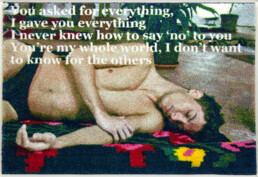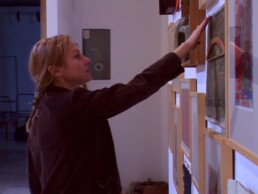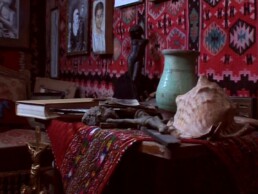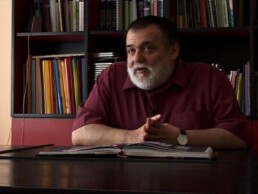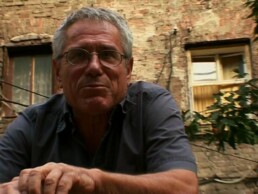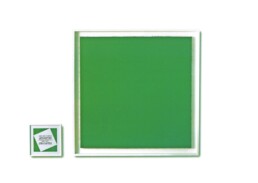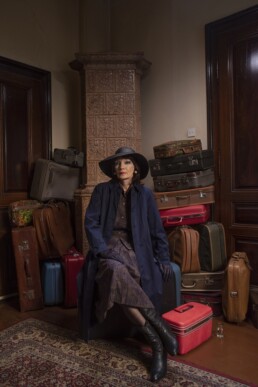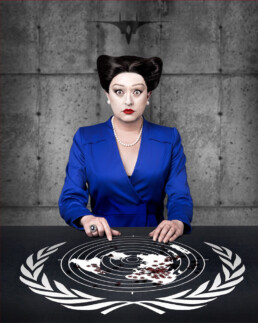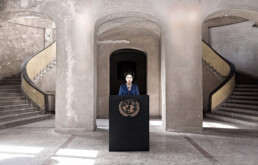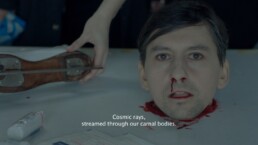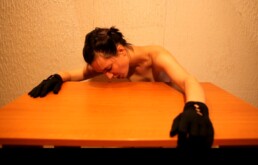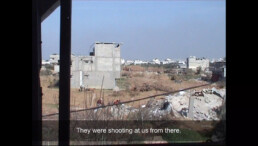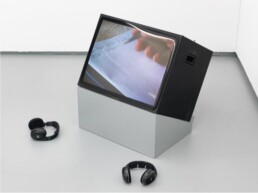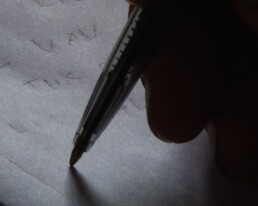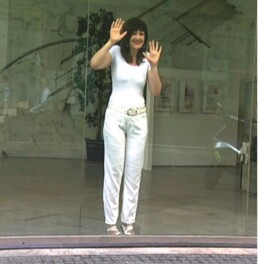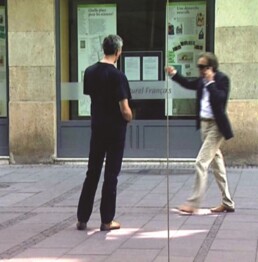IVANA IVKOVIĆ
IVANA IVKOVIĆ (1979)
I Gave You Everything
installation, carpet – polypropylene, wool
120 cm x 170 cm
2017
I Gave You Everything
installation, carpet – polypropylene, wool
120 cm x 170 cm
2017
The work is part of the series of installations with tapestries realized within her solo exhibition Babylon the Great, at the Eugster Gallery || Belgrade, 2017. The male body is the central motif and performative instrument that prevails in various ways in the scenes and relationships in this series of works.
The chosen motifs follow up on the Lines, Rows, Columns (Dormitory) Art Project, performed at the 56th October Salon.
The artist takes over some segments of this ambient installation through the photographic documentation that served as a starting point and visual template for creating larger tapestries. The installation I Gave You Everything and the choice of material and form, but also the function of the carpet itself, as an object that refers to the intimate environment of our lives, strongly proposes the appropriation of intimacy as such. The male body is used here both as a subject and object. As the artist points out, men, equally adored and demonized in the Serbian culture of the 1990s, and especially their physical presence and appearance, became an obsession in pop-folk songs, music videos, films, but also in real life. This phenomenon emerged as a consequence of social change, war, anxiety and fear. Perceiving the man as a soldier (early 1990s), a potentially dangerous criminal or a damaged boy from the street, paradoxically, puts the male body in the position of objectification, observation and, therefore, vulnerability. These are constructs of personal relations towards issues of gender identity and integrity, by which the author tries to locate the limits of her own female perspective in perceiving and understanding the otherness, i.e., men.
© Cultural Centre of Belgrade, October Salon Collection and the artist
Purchase Contract: III-5-370/24.10.2019.
Inventory No. 1658
Photo: Courtesy of the artist
Selected Bibliography:
56th October Salon, The Pleasure of Love. Cultural Centre of Belgrade, 2016
Ivana Ivković: Babylon the Great, Oct. 27 – Nov. 18, 2017, solo exhibition, text by Ana Bogdanović, Eugster, Belgrade, Belgrade, 2017
ABOUT THE AUTHOR:
Ivana Ivković (1979, Belgrade, Serbia) graduated in painting and obtained a master’s degree in drawing from the Faculty of Fine Arts in Belgrade. Since 2002, she has had a number of solo exhibitions in Serbia, Austria, Germany, Lebanon, Italy, Spain, USA, Turkey, Denmark, Canada, India and participated in several important group exhibitions in the country and abroad. She was a finalist for the Politika Award for the most successful exhibition three times, in 2007, 2010 and 2019. Her works are part of the Telenor Collection of Contemporary Serbian Art, permanent collection of the Belgrade City Museum and some significant private collections in New York, Basel, Lisbon and Turkey. More information at https://www.eugster-belgrade.com/artists/ivana-ivkovic/
IGOR GRUBIĆ
IGOR GRUBIĆ (1969)
Individual Collectivism
24 TV portraits of artists (video)
120’12”
2009
Individual Collectivism
24 TV portraits of artists (video)
120’12”
2009
“Having received an invitation from Branka Andjelković, the art director of the 50th October Salon, to make a work for the needs of the mentioned exhibition, I first researched the information about the context in which this art event was to take place.
Considering that the financial resources for the realization of the Salon were reduced in 2009, due to the economic crisis, Branka Andjelković made what seemed to me a brave decision to, in such circumstances, reduce the number of participants and concentrate exclusively on the local scene and include only local artists, giving them a financial support for the production of works, unusual before. As Branka Andjelković titled the exhibition ‘Circumstance’, I wondered in what circumstances contemporary art lived in this area, what was the relationship between artists and society, i.e., how artists thought the society and how the society thought or experienced contemporary art.
I remembered that in the previous few years most people active in culture and artists had talked about the lack of cultural programmes on Serbian televisions – mosaic programmes, interviews or portraits. TV portraits of artists in shorter or longer documentary form had not been made on Serbian televisions for years. So I came up with the idea to create a series of documentary TV portraits with all the participants of the October Salon (and decided to act in the fields of PR and marketing).
My basic idea was to bring contemporary art closer to a wide audience. We are all aware of the non-presence of contemporary art in the mass media, as well as its absence from the education system, which is maybe what leads to a situation in which, at the beginning of the 21st century, contemporary art appears distant and foreign to people.
In the form of TV portraits in which artists talk about their work in a simple way, I tried to show the viewers that their work is very much alive and close to everyday problems and topics that each of us encounters and deals with.
The name of the project ‘Individual Collectivism’ refers to an individual who relies on another, who contemplates their community, society. This individual builds relationships and develops a network of acquaintances. When an individual who is a true cultural/spiritual worker, seeker develops cognitively and spiritually and moves forward, their entire network, indirectly or directly, also develops and moves.”
Igor Grubić
Branka Anđelković. Phil Collins. Miljenko Dereta. Uroš Đurić. Biljana Đurđević. Bojan Fajfrić. Ivan Grubanov. Igor Grubić. Živko Grozdanić. Jamesdin. Žolt Kovač. Marko Lulić. Mauzoleum. Zoran Naskovski. Peđa Nešković. Vlada Nikolić. Oleg Novković. Darinka Pop-Mitić. Branimir S. Trša. Zoran Todorović. Raša Todosijević. Borut Vild. Katarina Zdjelar. Želimir Žilnik.
Journalist: Sandra Grubić
Cameraman: Josip Ivančić
Editor: Zoran Minić
© Cultural Centre of Belgrade, the October Salon Collection and the artist
Gift Contract: III-5-528/28.12.2018.
Inventory No. 211
Photo: stills from a video portraits
ABOUT THE AUTHOR:
Igor Grubić (1969, Zagreb, Croatia) is an artist, filmmaker and performer. His work includes photography, video and artistic activism. From 1997 to 1999 he studied at the Multimedia Art Department of the Academy of Fine Arts in Zagreb, the Editing Department of the Academy of Dramatic Arts in Zagreb and at the Faculty of Philosophy of the Society of Jesus. In 1998, he received the Crni peristil [Black Peristyle] Award at the 33rd Zagreb Salon. His numerous projects have been presented at solo and group exhibitions in Croatia and abroad. Since 2000 he has also worked as a producer and author of documentaries, TV reports and socially responsible commercials. He represented Croatia at the 58th Venice Biennale.
DUŠAN OTAŠEVIĆ
DUŠAN OTAŠEVIĆ (1940)
Case
oil on canvas, digital print
114 cm x 114 cm x 4.5 cm, 29 cm x 29 cm
2017
Case
oil on canvas, digital print
114 cm x 114 cm x 4.5 cm, 29 cm x 29 cm
2017
The installation Case illustrates Otašević’s characteristic method of work: remaking of non-artistic materials, popular urban objects, images that belong to local or international popular and everyday culture, media clichés, cultural stereotypes. From the mid-seventies until today, Otašević has shown and developed, in some rudimentary form, a tendency to rearrange something that is recognizable, so the wall installation Case, combines Malevich’s Black Square and Kharms’s Cases into a strange remix.
In Dušan Otašević’s works, there are specific phenomena and relations associated with the art of post-production, which includes sampling and remixing in the context of the avant-garde, pop art and postmodernism, such as appropriation, editing, citation, recycling. The fundamental concept of the remix culture is based on the act of appropriation and use of the existing material so that the artist creates something new, in accordance with their wishes. His style is often characterized as a specific variant of pop art in the Yugoslav, socialist-modernist art context, where the artist does not process branded products, but products of everyday general use. The art of Dušan Otašević is socially committed and in his works he combines criticism and irony. With the reduced technological/craft procedure in his works, he consciously demystifies the process of creation. They are mostly multimedia objects with wood as the dominant material.
© Cultural Centre of Belgrade, the October Salon Collection and the artist
Purchase Contract: III-5-381/1.11.2019.
Inventory No. 1663
Photo: Cultural Centre of Belgrade
Selected Bibliography:
Dušan Otašević: Gozba, Mar. 27 – Apr. 22, 2018, catalogue of the solo exhibition, text by Jasmina Čubrilo, Nadežda Petrović Art Gallery, Čačak, 2018
ABOUT THE AUTHOR:
Dušan Otašević (1940, Belgrade, Serbia) graduated from the Academy of Fine Arts (now Faculty of Fine Arts) in Belgrade in 1966, in the class of prof. Ljubica Cuca Sokić. Since 1965, he presented his works done in various media (paintings, objects, installations, drawings, graphics, collages) at about fifty solo and more than a hundred and fifty group exhibitions in the country and abroad. Since the beginning of the seventies, he has also done theatre scenography. He taught at the Academy of Fine Arts in Belgrade from 2000 to 2006. In 2003 he was elected a corresponding member of the Serbian Academy of Sciences and Arts, and became a full member in 2009. Since 2011, he has been the director of the SASA Gallery. His works are part of numerous museum and gallery collections (Museum of Contemporary Art in Belgrade, National Museum in Belgrade, Belgrade City Museum, SASA Art Collection, Collection of the House of the Army of Serbia, Zepter Museum in Belgrade, Fine Arts Gallery in Osijek, etc.) and many private collections in the country and abroad. He received a Captain Miša Anastasijević Charter for his contribution to culture (2014), the 18th Nadežde Petrović Memorial Award (Čačak, 1994), the October Salon Award for painting in 1993, etc. Lives and works in Belgrade.
DEJANA VUČIĆEVIĆ
DEJANA VUČIĆEVIĆ (1976)
Suitcases
digital photography on photo paper
150 cm x 100cm
edition: 1/5
2018
Suitcases
digital photography on photo paper
150 cm x 100cm
edition: 1/5
2018
The Cumulation Project deals with accumulation on the global level while at the same time retaining an atmosphere of intimist mood, which reflects the inner world of the owners through the accumulated antique objects. The heroines of this series are also the actors placed in the centre of the composition on each individual photograph. They are wandering in their infatuation and fascination with all kinds of burdens and, within the psychological explanation of the state, the heroine of each frame flirts with criticism and self-criticism.
The ambiance, costume and attitude of the heroine in this photograph, which is part of the October Salon Collection, as well as the choice of items she collects – suitcases – sheds light on the origin and status of the portrayed woman, and the accumulation of objects looks like an obsessive need and echoes in their inner psychic state, giving the photograph a touch of Vanitas, a symbolic image of the transience of life and the futility of pleasure.
In her photography projects, the artist arranges a mise en scène, relying on costumes and scenography mainly from the second half of the 20th century. With stylistic and iconographic juxtapositions in her works, she leans on the figural clichés of advertising and film photography, adding irony to the aesthetics of the pretentious dreams and pompous images of the media. Her oeuvre is based on the themes of family, relationships, loneliness, alienation, loss of identity, the existence of the woman and her position in relation to the established norms of socially desirable behaviour, all through the contexts of the last years of the 20th century.
© Cultural Centre of Belgrade, October Salon Collection and the artist
Purchase Contract: III-5-403/8.11.2019.
Inventory No. 1665
Photo: Courtesy of the artist
Selected Bibliography:
Dejana Vučićević – CUMULATION. August – September 2018. Text by Jelena Krivokapić, Solo Exhibition Catalogue, Beograd Sales Gallery, Belgrade, 2018; Available at: http://galerijabeograd.org/wp-content/uploads/2018/08/katalog-dejana-vucicevic-screen2.pdf (accessed Mar. 18, 2020.)
56th October Salon, The Pleasure of Love. Cultural Centre of Belgrade, 2016
ABOUT THE AUTHOR:
Dejana Vučićević (1976, Belgrade, Serbia) graduated from the Faculty of Applied Arts in Belgrade. She is a member of ULUPUDS (Association of Applied Arts Artists and Designers of Serbia) and a freelance artist. As a visual artist, she has realized several significant solo projects in the field of design and fashion, such as fashion collections, costumes for three feature films and one short film. She does costume design and designs for theatre and TV commercials projects, styling for fashion and art editorials. In the field of multimedia arts, she deals with conceptual projects, realized at solo exhibitions. Her works are part of the October Salon Collection, the collections of the Belgrade City Museum, Museum of Applied Art in Belgrade, and the Telenor Collection of Serbian Contemporary Art. More information at http://www.dejanavucicevic.com/
BRANKO MILISKOVIĆ
BRANKO MILISKOVIĆ (1982)
Appointed
live performance
photograph c-print, photo: Danilo Mataruga
80 cm x 100 cm
edition: 1/10
2018
Appointed
live performance
photograph c-print, photo: Danilo Mataruga
80 cm x 100 cm
edition: 1/10
2018
In the three-hour public performance Appointed, Milisković presents eight inaugural speeches of previous United Nations Secretaries from 1946 until today. The performance was premiered at the 57th October Salon; for the first time in history, the new constructed body of the fictive Secretary-General of the United Nations was a “woman”.
In 2016, Milisković spent three months at the EoFA artist-in- residence programme in Geneva, where the idea for this performance came about. His initial plan was to legally enter the United Nations premises and make a photographic session in Ariana Park, which is the UN quart protected territory. After numerous unsuccessful attempts to obtain a legal permission to get an access to the mentioned premises, revolted and humiliated, he came up with the idea to construct his body into the body of the new Secretary-General of the United Nations and take that fictive position – Woman Secretary-General.
With a highly stylized and artfully perfected form of performance, he problematizes a number of current social and political topics, from gender issues to the relationship between the individual and the structures of power and authority. In order to give a clear critique against the rules that apply on the UN territory, against strict security measures and a double steel fence that defends the main gate from possible attacks by the civilians, against the concept of a “secret” society and parallel with that carrying the epithet “global peacekeeper”, Milisković decided to construct and inaugurate a new body of a fictive Secretary-General of the United Nations with an unlimited mandate.
© Cultural Centre of Belgrade, the October Salon Collection and the artist
Purchase Contract: III-5-444/2.12.2019.
Inventory No. 1667
Photo: Courtesy of the artist, Danilo Mataruga, installation view 57th October Salon, photo Boris Burić
Selected Bibliography:
57th October Salon, The Marvellous Cacophony. Cultural Centre of Belgrade, 2018
Milena Dragičević Šešić, Mirjana Nikolić, Situating Populist Politics: Arts & Media Nexus, Faculty of Dramatic Arts, Institute for Theatre, Film, Radio and Television, Belgrade: Clio, 2019, 138–139.
ABOUT THE AUTHOR:
Branko Milisković (1982, Belgrade, Serbia) studied sculpture at the Faculty of Fine Arts in Belgrade, in the class of Professor Mrđan Bajić; continued the postgraduate studies as a Dutch government scholarship holder at the Royal Academy of Art in The Hague and graduated from the Department of 3D Art in 2009; obtained a master’s degree in extended media from the Hochschule für Bildende Künste in Hamburg, under Professor Jeanne Faust in 2012. He is dedicated to live performance, mono-opera, cabaret, photography and film. His works have been realized at numerous prestigious local and international festivals, exhibitions and artist-in- residence programmes, included in the books Performance Art in Eastern Europe since 1960 by Dr. Amy Bryzgel and Situating Populist Politics: Arts & Media Nexus by Milena Dragićević Šešić and Mirjana Nikolić, as well as in many publications, magazines and newspapers. Branko Milisković is a free-lance artist, a member of ULUS (Association of Fine Artists of Serbia). More information at https://brankomiliskovic.wordpress.com/
BOJAN FAJFRIĆ
BOJAN FAJFRIĆ (1976)
The Cause Of Death
HD video
13’
2015
The Cause Of Death
HD video
13’
2015
Positioning the Black Wave of Yugoslav cinema at the centre of social change, Bojan Fajfrić’s video work The Cause of Death revives the legacy of that movement through examining the possibilities of art to encourage system shifts. Uniting collective and personal experience, he plays with the boundaries of recognisability of both, in a changed context.
It was shown at the 56th October Salon and received the Cultural Centre of Belgrade Award.
The New Yugoslav Film, better known as ‘Black Wave’, was a prolific phase in the Yugoslav cinema in the mid-1960s and early 1970s. It introduced the failure of the protagonist as a means of critical examination of the society. The authors of these films rejected the rules and results of the official optimistic culture, and openly exposed the dark side of the Yugoslav socialist society, caused by the implementation of market economy and its harmful social consequences. In The Cause of Death, the author takes over the personalities of 5 major Black Wave iconic characters and re-enacts their culminating scenes. These characters are: Milena from the film W.R. Mysteries of the Organism (1971) by Dušan Makavejev; Jugoslav from Early Works (1969) by Želimir Žilnik; Ivo, from The Ambush (1969) by Živojin Pavlović, Tom, from Plastic Jesus (1971) by Lazar Stojanović and Džimi Barka, from the film When I Am Dead and White (1967) by Živojin Pavlović.
© Cultural Centre of Belgrade, the October Salon Collection and the artist
Purchase Contract: III-5-426/2.11.2018.
Inventory No. 1606
Photo: still from the video work
ABOUT THE AUTHOR:
Bojan Fajfrić (1976, Belgrade, SFRY) lives and works in Amsterdam. He left Yugoslavia in 1995 and went to the Netherlands to study art. He graduated from the Royal Academy in The Hague and was a resident artist at the Rijks Academy in Amsterdam. Exhibitions: La Triennale: Intense Proximity, Paris; Theta Rhythm, Baltic Centre for Contemporary Art, Gateshead; 1966 I Constellations Gaur I 2016, San Sebastian; STEM TERUG! VOTE BACK!, De Appel, Amsterdam; Was ist Kunst…Resuming a Fragmented History, Graz; The Suspension of Time – Spaceship Yugoslavia, NGBK Berlin; December 5, 1978, Museum of Contemporary Art, Belgrade; The Symbolic Efficiency of the Frame, Tirana Contemporary Art Biennial. Film festivals: Tempo Documentary Festival, Stockholm; Recontres Internationales Paris / Berlin / Madrid; International Film Festival Rotterdam; International Short Film Festival Oberhausen; International Film Festival in Vienna; Dok Leipzig; Impakt Festival, Utrecht. More information at www.leavidakovic.com
ANTONIA BOŽANIĆ
ANTONIA BOŽANIĆ (1991)
The Surplus
video
8’ 40”
2014
The Surplus
video
8’ 40”
2014
The work deals with the feeling of misunderstanding and hopelessness. A sort of masochistic acceptance of the state of affairs is expressed. All that is feminine, all that must be adapted to the hardened dead forms is shown, but in the very disclosedness of this action lies a large dose of defiance.
The work was exhibited at the 56th October Salon, The Pleasure of Love.
The Surplus shows a female person (the artist) as she is licking the surface of a table. Referring to a variation of BDSM (Bondage/Discipline, Sadism/Masochism), domination and submission, the artist places herself in the position of a submissive, where she gives control to the dominant in the ritualized act of sharing power. Since the figure to be obeyed is not physically present or we do not see them, the work also speaks of the relationship between desires and expectations. Namely, bearing in mind that the work was created during her master’s academic studies, the act of the author, i.e., the video performance, in this sense, can also be understood as a desire to “obey”, i.e., to adapt to the professional criteria set by the institution, in fact, by the professors.
“When I bring to mind the act of licking the surface of the table, I remember my masochistic desire to be subjugated and controlled. Performing this twisted action made the taste of senselessness sweeter. The feelings of misunderstanding and hopelessness were not something I would resist, but something I was completely at peace with. And more than that, something I liked and loved.” (A. Božanić, Catalogue of the 56th October Salon).
Over time, in the action she performed, the author has recognized the part of herself that needs integration. In this sense, the work also draws attention to the fact that coping with problems is an individual process, but that changes occur only in the relationship between the individual and the world.
© Cultural Centre of Belgrade, the October Salon Collection and the artist
Purchase Contract: III-5-456/14.11.2018.
Inventory No. 1624
Photo: still from the video work
Selected Bibliography:
56th October Salon, The Pleasure of Love. Cultural Centre of Belgrade, 2016
BUG 4/2, Exhibition of students of the Faculty of Fine Art within the subject of Transmedia Research 2013-2014, February 16, 2015, 12 HUB Gallery, Belgrade, 2015.
ABOUT THE AUTHOR:
Antonia Božanić (1991, Belgrade, Serbia) completed her basic and master’s studies at the Faculty of Fine Arts, University of Arts in Belgrade. She has exhibited mainly in Serbia, at various student and group exhibitions, the most significant of which are: When the OTHER Meets the OTHER, Galleries of the Cultural Centre Belgrade, Belgrade (2017); BUG 4/2, G12 Hub, Belgrade (2015); Transsampler, within Festum at the Student Cultural Centre, Belgrade (2014); BUG 3/2, Magacin u Kraljevića Marka, Belgrade (2012). She lives and works in Belgrade.
Artur Żmijewski
ARTUR ŻMIJEWSKI (1966)
Operation Cast Lead
film
21’51”
2009
Operation Cast Lead
film
21’51”
2009
Artur Żmijewski’s works were exhibited at the 49th (Them, 2007) and the 52nd October Salon (Them, 2007 and Repetition, 2005). He was awarded the Cultural Centre of Belgrade’s Award at the 52nd October Salon, which includes the realization of a solo exhibition. The solo exhibition titled Democracies, within which a series of 16 films was screened, was realized in 2013 at the Art Gallery.
The film tells the story of the brutality and senselessness of the Israeli military attacks carried out in Gaza in 2009. It is a story of victims, demolished homes and destroyed human lives. It is a montaged video material recorded by activists of the B’Tselem Group –Israeli Centre for Human Rights in the Occupied Territories, as well as by Gaza residents themselves.
Originally, the work was accompanied by 16 drawings made during Artur Żmijewski’s talks with residents of Holon and Tel Aviv, on what was happening in Gaza. The artist asked these people to draw what they were talking about so this edition of the work is titled My Neighbours and fully reflects the mental condition of Israeli citizens at this specific moment in history.
Believing that art is about defining a political problem, that it focuses on burning issues and thus helps to change something, in his art practice he primarily deals with “unpleasant“ topics, those that fall into the area of taboos, the problems of the human body, the Other, but also the long-term traumas caused by historical and socio-political developments such as the Gaza war interventions.
© Cultural Centre of Belgrade, October Salon Collection and the artist
Gift Contract: No. III-52-166/05.08.2013
Inventory No. 004
Photo: still from the film
Selected Bibliography:
49th October Salon, Artist – Citizen. Cultural Centre of Belgrade, 2008
52nd October Salon, It’s Time We Met Each Other. Cultural Centre of Belgrade, 2011
Artur Żmijewski, Democracies, Sep. 25 – Oct. 13, 2013, Art Gallery, Exhibition Catalogue, Cultural Centre of Belgrade
Artur Żmijewski, Trembling Bodies, conversations with Artists, Kronika & Berliner Kunstlerprogramm DAAD, 2010
https://www.peterkilchmann.com/artists/artur-zmijewski/overview/my-neighbours-2009
ABOUT THE AUTHOR:
Artur Żmijewski (1966, Warsaw, Poland) is considered one of the most controversial Polish artists of his generation, whose works are most often in the medium of photography and film. On the world art scene, he is known for his experimental work, mostly with marginal social groups. He is one of the main representatives of the critical art trend. He represented Poland at the Venice Biennale in 2005 and was the curator of the Berlin Biennale in 2012. He has exhibited his works at numerous solo and group exhibitions around the world.
Katarina Zdjelar
KATARINA ZDJELAR (1979)
Shoum (study)
video
7’
2010
AAA (Mein Hertz), frame
digital file
variable dimensions
2016
Shoum (study)
video
7’
2010
The video work focuses on the “infantile” practice of learning without understanding. A middle-aged person from Belgrade was recorded in the process of decoding the lyrics of a song that is, presumably, their favourite music hit from the youth, from the 1980s: it is the song Shout by the British new wave / new romantic pop band Tears for Fears. The experience of listening to the English language translates into the experience of speaking it.
The work Shoum was exhibited at the 50th October Salon.
The man who decodes the lyrics does not speak English at all, so he phonetically transcribes what he hears based on his own “vocabulary” and the capacity to vocally interpret and reproduce what he hears. In order to understand and memorize the words of the song, he writes down what he understands as English. Through errors and deformations of the words of the song, a fun “new language” is created, so that instead of “shout, shout, let it all out, these are the things I can do without …”, he writes “šaum, šaum, lejdi o lav, pizat d pizat du ju raund…” and goes on in that style until he writes the text of the whole song. In the end, he sings his version of the song to the lyrics he wrote himself. The intended meaning of the song, its cultural context and its specificity are lost in order to give way to a “personal language” …
Branislav Dimitrijević, from the catalogue of the 50th October Salon
© Cultural Centre of Belgrade, October Salon Collection and the artist
Purchase Contract: III-5-294/12.8.2016.
Inventory No. 1428
Photo: still from the video work
Selected Bibliography:
50th October Salon, Circumstance. Cultural Centre of Belgrade, 2009
AAA (Mein Hertz), frame
digital file
variable dimensions
2016
The work AAA (Mein Hertz) was exhibited at the 57th October Salon The Marvellous Cacophony in 2018.
AAA (Mein Hertz) is a single-shot work showing a young woman simultaneosly performing four compositions. While preserving the original style, tempo, and rhythm of the individual works, she maintains the key of the different musical pieces. Silence, music, sound and words alternate and collide. The female protagonist’s face and vocal chords serve as a battleground for the jerky transition between the different tracks. As if the sound have been continuously torn out of their sockets putting an amphasis on the multiple, fragmented yet simultaneous temporalities which run the economy of her voice and of the composition. As often in Zdjelar’s practice, it is the interruptions that speak, this time in the corporality of the performer’s voice. Her singing is as much about managing the gaps between the tracks as it is about accuracy of performace of such historically, stylistically and linguistically distinct compositions.
From the catalogue of the 57th October Salon
© Cultural Centre of Belgrade, October Salon Collection and the artist
Purchase Contract: III-5-334 /26.11.2021
Inventory No.
Photo: still from the video work
Selected Bibliography:
57th October Salon The Marvellous Cacophony. Cultural Centre of Belgrade, 2018.
ABOUT THE AUTHOR:
Katarina Zdjelar (1979, Belgrade, Serbia) graduated from the Piet Zwart Institute in Rotterdam and the Academy of Applied Arts in Belgrade. Lives and works in Belgrade and Rotterdam. In 2017, Katarina was shortlisted for the Dutch Prix de Rome and won the Dolf Henkes Art Award. She has presented her works at the Stuki Museum of Modern Art, Lodz; Kunstverein Bielefeld; Serbian Pavilion at the 53rd Venice Biennale; Museums of Contemporary Art in Barcelona (MACBA) and Bucharest (MNAC); De Appel Centre for Contemporary Art, Amsterdam; 5th Marrakesh Biennale; Power Plant Gallery of Contemporary Art in Toronto; Witte de With Centre for Contemporary Art, Rotterdam; HMKV in Dortmund; MuHKA Museum in Antwerp; Total Museum of Contemporary Art, Seoul, etc. More information at www.katarinazdjelar.net
Dragana Žarevac
DRAGANA ŽAREVAC (1959)
Entre nous reedited
two-channel video
3’57’’, 5’58’’, in loop
2007–2016
Entre nous reedited
two-channel video
3’57’’, 5’58’’, in loop
2007–2016
The installation, a video performance by Dragana Žarevac, consists of two recordings – one shows a woman, visibly exhausted, trying to establish communication and calling out for a man on the other side of the glass wall; in the other video, the man the woman is addressing, turned away, does not notice the messages being sent to him. Responding to the theme of the Ilemouvante Festival (Corsica, 2007), “the wall”, the artist directly and metaphorically points to walls and barriers that prevent communication between people, which are sometimes completely invisible, but thereby no less impermeable. With the work Entre nous, the artist primarily re-examines the relationship between the woman (herself – a professional artist) and the man in the community.
With the video performance Entre nous, and with her decades-long work in performance and video performance as a personal statement, Dragana Žarevac deals with the relationship among woman, art and society. She often uses, examines and communicates ideas that are almost always focused on the biological category of gender, the notion of time (past, memory and projection of the future), the space of society and the space of ideas. She builds a personal work, in the first person, in the sense that she relies on what is current in all its factors – aesthetic, historical, political, social – she liberates them and returns them to the game by working on their reshaping and redefining. Opposing the definitive versions, she engages in exploring the dynamics of the collective imagination, from symbolic labels to the historical past, with the aim to express her version of the world and by it, like many other contemporary artists, to redefine – if necessary – the artist in the position of a discoverer, guide, who themself is a medium (self media).
© Cultural Centre of Belgrade, October Salon Collection and the artist
Purchase Contract: III-5-373/16.11.2016.
Inventory No. 1447
Photo: still from the video work
Selected Bibliography:
Dragana Žarevac: Vera u progres, Oct. 23. – Nov.14, 2008, catalogue of the solo exhibition, texts by Dragana Žarevac and Etienne Sandrin, Nadežda Petrović Art Gallery, Čačak, 2008
ABOUT THE AUTHOR:
Dragana Žarevac (1959, Belgrade, Serbia) is a visual artist. Her exhibiting career began in 1979, with performances at the Student Cultural Centre in Belgrade and numerous gallery spaces in the former Yugoslavia and abroad. Her work is characterized by a personal attitude on issues of general social importance. The artist, in an original way, integrates the experiences of historical conceptual art and some of the most vital plastic and conceptual solutions created at the intersection of two media, performance and video art. She exhibits video works and installations, drawings and works in the medium of sound. She was awarded by the Centre for Art and Media Technology (ZKM) in Karlsruhe (1998), won the Zlatna sfinga [Golden Sphinx] Award for the video opus at the Videomedeja Festival in Novi Sad (1999) and the 23rd Nadežda Petrović Memorial Award (2005). She was a resident artist in the ZKM Centre, Karlsruhe; CICV Centre, Hérimoncourt; and in Sant Antonino, Corsica. She also works as a curator and selector of video programmes, international video festivals and exhibitions, and organizes video workshops. More information at https://zarevac.wixsite.com/zarevac
